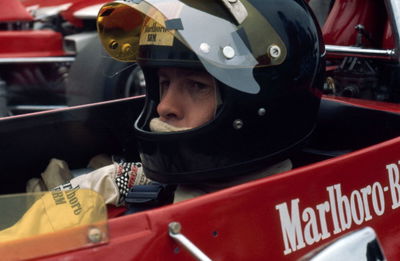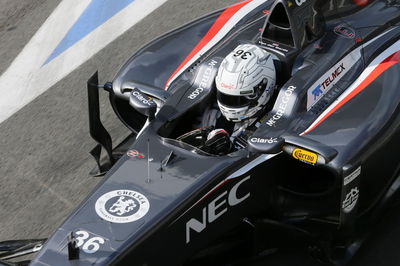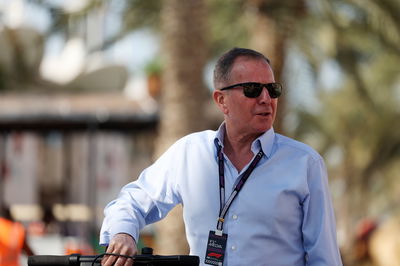In memory of ... F1's closest finish

The Autodromo Nazionale Monza is one of Formula One's most evocative destinations, prompting memories of blazing early autumn sunshine, the leafy ambient setting in woodland surrounding the Royal Villa of Monza and, most of all, a defining association with raw, primal speed.
The venue for the Italian Grand Prix during every season of Formula One racing except 1980, Monza has played host to championship deciders, seminal races and an unfortunately frequent dose of tragedy during F1's formative years.
In 1971, Monza also bore witness to one of the most remarkable races in Formula One history - a final monument to its original chicane-free status as a cathedral of speed that saw Peter Gethin take his only Grand Prix victory in a slipstreaming epic, heading home a five-strong chain of cars separated by just 0.6 seconds in Formula One's closest-ever finish.
THE CIRCUIT
Monza's hallowed tarmac may appear to be an eternal constant, but the circuit has undergone several modifications since its construction in 1922, with several different configurations used for Formula One Grands Prix. The most famous layout of Monza was that used from 1957-59 and 1962-71, with a chicane-free 5.75 km (3.57mi) circuit driven virtually flat-out through the Curva Grande, up towards the first braking zone at the unchanged Lesmo turns, before blasting full-throttle through the left-hander now known as the Variante Ascari and sliding around the Parabolica to complete the lap.
It was a configuration tailor-made for slipstreaming, with the 'pre-downforce era' cars able to run close enough to each other through the blend of corners to benefit from what were frequently multi-car slipstreams on the long high-speed sections. Given the inherent difficulty of breaking away from the pack, the lead would often be closely contested to the flag - as illustrated by the desperately close finishes to the 1967 and 1969 Italian Grands Prix.
THE BACKGROUND
With such high speeds came high risks, and for all of the iconic joys of Monza, so too there were tragedies. A list of luminary names, including Italy's last champion, Alberto Ascari, Count Wolfgang von Trips and, in 1970, Austrian racer Jochen Rindt had all perished around Monza's notorious curves. Von Trips' accident in 1961, which also claimed the lives of 14 spectators, prompted race organisers to retire the famous banked section over safety concerns about rising speeds, and so too Rindt's fatal crash was a catalyst for a revision of the circuit.
Monza had always been frighteningly fast, but the increase in speeds as Formula One developed made the free-flowing layout untenable. From a pole position average lap speed of 116 mph in 1950, to 138 mph in 1960, and up to 152 mph by 1970, the circuit's average speed was ever increasing - and was over 20 mph faster than any other track on the calendar - with top speeds hitting 185 mph as cars diced wheel-to-wheel on the virtually barrier-free straights.
Change was inevitable, and two chicanes, one at the start/finish line and another at the Variante Ascari, would be installed ahead of the 1972 race and reduce average lap speed by over 20 mph. Before then though, Monza played host to one final slipstreaming classic: the 1971 Italian Grand Prix.
THE CONTENDERS
It had been a season dominated by Jackie Stewart's Tyrell-Ford, with the Scot winning six races en route to a second World Championship. With the title sewn-up in double-quick fashion at the eighth round of the eleven-race season in Austria, as the field converged for race nine, the Italian Grand Prix, there was only pride left to play for - and an opportunity for up-and-coming drivers to prove themselves.
Lotus, who had endured a difficult season, were still embroiled in legal difficulties with the Italian authorities as a result of Rindt's fatal accident 12 months previously, and as such didn't enter the race. The rest of the field was strong though, with no fewer than five March-Fords, four BRMs and three Surtees-Fords taking the startline alongside the home-favourite Ferraris of Clay Regazzoni and Jacky Ickx. At the previous race in Austria, a similarly flat-out circuit, Jo Siffert of BRM had taken victory, and the British marque, represented by Siffert, Howden Ganley, Peter Gethin and one Helmut Marko, were considered favourites by virtue of their powerful V12 engine.
The art of slipstreaming was as essential in practice as it was in the race at Monza. With six hours of official practice, all counting for grid positions, timing was everything. It was to be New Zealander Chris Amon who judged the conditions most effectively, powering his Matra to pole position with an average speed of 156 mph and time of 1:22.40 (before electronic timing, laps were only measured to the hundredth of a second) - four tenths clear of Ickx's Ferrari. The Scuderia had been suffering a miserable season, but a mid-practice change of tyres from Firestone to Goodyear improved the performance of the unwieldy 312/B.
For pre-race favourites BRM, qualifying had been a mixed bag. Siffert and Ganley had performed strongly as expected, lining up on row two, but Gethin and Marko had struggled, lining up 11th and 12th, 1.5 seconds off the pace. For Gethin, who had scored just one point in his first 15 Grands Prix and left McLaren halfway through the season, midfield anonymity was par for the course. Little could he, let alone anyone else, have foreseen what would unfold on race day.
THE RACE
The grid lined up under stifling conditions, but it was to be a scarlet Ferrari who would make the hottest start. Suspiciously powering through from eighth on the grid, Clay Regazzoni's Ferrari got the jump on the entire field as Amon and Ickx bogged down, and led into the first corner.
The first ten laps were defined by the usual slipstreaming amongst the leading contenders, with neither of the challengers able to break away and Regazzoni, Ronnie Peterson's March and Stewart's Tyrrell all took turns heading the pack over the line.
Given the emphasis on straight-line speed, many teams and drivers pushed their motors to the limit with customised gear ratios and a predilection for maxxing out on revs through long gearshifts to maintain momentum. Thus, it was no surprise that Monza was as famous for attrition as it was for speed - and the retirements mounted accordingly. Within three laps of each other Stewart, Regazzoni and Ickx all fell foul of engine gremlins, robbing the race of three of its marquee names and ending the Tifosi's interest in proceedings by lap 18.
Peterson and the remaining Tyrrell of Fran?ois Cevert continued to rotate at the front as positions swapped frantically through the field, although the most eye-catching progress was made by Mike Hailwood's Surtees-Ford. Having started 17th, former motorbike world champion Hailwood was demonstrating some aptitude for Monza's slipstreaming characteristics - and his rise through the field was made all the more remarkable by the fact that it was his first Formula One race for six years.
Hailwood worked his way into the leading fray, seizing the lead from Peterson on lap 25 as part of a sequence that saw the lead change hands on seven consecutive laps - culminating in Siffert emerging at the head of the field on lap 28.
Siffert's charge would prove short-lived though, the BRM sticking in fourth gear and dropping the Belgian out of contention. This left a leading group of Peterson, Cevert, Hailwood, Amon, Ganley and Gethin - neither of whom had ever won a Grand Prix. The final 25 laps would prove to be a frenetic showdown between eight men, hungrily racing inches apart at over 180 mph, scrapping tooth and nail for a maiden victory.
Amon, regarded by many as the best driver to never win a Grand Prix, built up the most commanding advantage of the whole race with ten laps to go. However, Amon snatched defeat from the jaws of victory, in typically bizarre fashion, reaching for a tear-off strip from his helmet and inadvertently pulling off the entire visor. Suffering severe buffeting to his face, not to mention the risk of stones and debris being kicked up by his rivals, Amon dropped back, leaving a five-strong nose-to-tail tussle over the final laps.
Gethin finally made his push for the front on lap 52, taking the lead of a Grand Prix for the first time just three laps from home. However, as the cars came round to start the final lap Gethin's BRM was fourth, with Ganley having dropped back to the tune of half a second and seemingly out of contention in fifth.
Heading towards the Parabolica, the last corner, Cevert had victory in his sights, leading Peterson with Gethin up to third. Eyes lighting up with the prospect of victory, Peterson threw his March down the inside of Cevert's Tyrrell, taking the place but forcing both cars slightly wide. As Cevert and Peterson scrambled for grip, Gethin pounced, positioning the BRM perfectly to blast past both his rivals on the run to the line.
Gethin somehow found time to raise his fist as he crossed the line, leading home a blurring flash of cars - Gethin, Peterson, Cevert, Hailwood - all covered by 0.2 seconds, with Ganley a further 0.4 seconds back.
Across 25 lead changes, the eight separate leaders set a record that stands to this day, and Gethin's winning margin stood at 0.01 seconds - the smallest possible margin given the timing system of the time. It remains a record for closest finish by time between first and second, but also from first to third (0.09s), first to fourth (0.18s) and first to fifth (0.61s).
Measured in distance, the gap was an absurd 70cm, or two feet, after over 316km, or 196.5 miles, of racing. The race set a record as the fastest ever run, a record remarkably held until the 2003 Italian GP, and was the first Grand Prix with an average speed of over 150 mph.
THE AFTERMATH
Gethin's victory was a pure bolt from the blue. The Briton, best known for his prowess on the North American CanAm circuit, had only scored one point previously and would only score one further point in 13 more races before his F1 career petered out. Gethin subsequently ran a Formula 3000 team and passed away after a long illness in December 2011, aged 71.
Of the five chasing contenders, only Peterson and Cevert would go on to take victories in their Grand Prix careers, but both would tragically meet their ends behind the wheel before truly realizing their potential - Cevert at the 1973 United States GP and Peterson, ironically, at Monza on lap one of the 1978 Italian GP.
Fourth place represented Hailwood's best career finish, but he would go on to take two podium finishes before retiring after suffering severe injuries in an accident at the 1974 German GP. Fifth place represented Ganley's first points in F1, and he would go on to score eight further points before dropping out of F1 at the end of 1974.
A thought too for Chris Amon. A man with such a reputation for bad luck that Mario Andretti once quipped, "if he became an undertaker, people would stop dying", his misfortune at Monza was the latest in a series of notorious hard luck failures including the 1968 British and Canadian Grands Prix. Lightning never would strike for the Kiwi, and after a disastrous attempt to launch his own team Amon stepped away from F1 in 1976.
Usually in life it's said that the cream rises to the crop, but this was a race in which the established order fell by the wayside and left the mantle to the unheralded pretenders - who proceeded to produce a race for the ages. With the track blighted by chicanes for 1972, it was the last slipstreaming classic at Monza, and the thrilling conclusion remains, and probably always will be, Formula One's closest finish.











